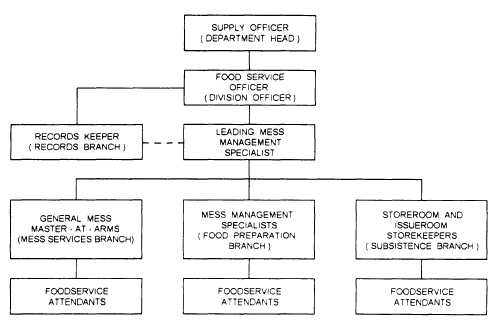| |
chart for a foodservice division of a small fleet unit is
illustrated in figure 13-1.
Records
As described in detail in chapters 2,3, and 12, GM
records are used to accomplish the following basic
processes:
l
l
l
l
l
l
Determining provision requirements
Preparing requisitions
Processing receipt and expenditure documents
Conducting inventories
Maintaining related files and records to account
for food items
Preparing related correspondence, reports, and
returns (financial statements)
The Food Service Management (FSM) system
automates many of the routine manual foodservice
records-keeping functions. The system uses the same
terminology, forms, and procedures as found in the
manual system. Since the system has been designed with
current regulations in mind, the software can be easily
used by an individual familiar with manual foodservice
records. The NAVSUP P-486, volume I, provides a
mandatory checklist and a Navy Food Service Systems
Office (NAVFSSO) recommended system access list,
which automated activities are encouraged to use.
Further information is available from the Terminal
Users’ Guide, which is distributed with the software.
This chapter discusses the use of foodservice
records as management tools that enable you to more
efficiently operate the mess. As the assistant to the FSO
in the GM, you should not have custody or control over
original financial records applicable to operating the
GM. However, you should have access to these records
and may have duplicates, as needed, for the effective
administration and operation of the GM.
Throughout this chapter the various processes of
foodservice management are discussed. Additionally,
examples of how GM records are used to assist in
managing all areas of the GM are provided.
Food Preparation
The FSO is directly responsible for making sure
foodservice personnel follow all section orders
concerning the proper preparation of food. As the
leading MS, you should make sure the FSO’s orders and
regulations are followed by all foodservice personnel.
In addition to the service of food, these orders and
regulations encompass such specifics as food
conservation, sanitation, scullery operation, and the
handling of food wastes. Managing these processes
requires setting up a strict routine for preparing and
serving food. This routine should include some of the
following actions:
Figure 13-1.-Typical organization of a foodservice division of a small fleet unit.
13-2
|

